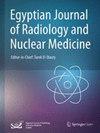磁共振弥散加权成像在 BIRADS 分期中的精确度
IF 0.5
Q4 RADIOLOGY, NUCLEAR MEDICINE & MEDICAL IMAGING
Egyptian Journal of Radiology and Nuclear Medicine
Pub Date : 2024-05-28
DOI:10.1186/s43055-024-01276-1
引用次数: 0
摘要
乳腺癌是发病和死亡的主要原因。因此,必须及时发现乳腺癌,以便采取更谨慎的手术治疗方法。长期以来,乳腺超声波检查一直是乳腺 X 线照相术的辅助技术,用于评估可触及或乳腺 X 线照相术可检测到的乳腺肿块。目前,乳腺磁共振成像已成为检测和分析乳腺癌的重要工具。扩散加权成像(DWI)是一种磁共振成像技术,可量化组织内水分子的运动。它能提供有关组织密度、粘度、膜完整性和微观结构的宝贵信息。本研究纳入了六十名 BIRADS 病变等灶/高灶患者,他们都接受了乳腺造影和/或 U/S、CEMRI 和 DWI 检查。本研究的目的是揭示 MRDWI 在描绘和评估不同乳腺病变时的功效,以避免 MRI 造影剂的高昂费用,减少不必要的活检次数,并可能对 BIRADS 高类别的乳腺病变进行重新分类。这项前瞻性研究纳入了 58 名患者(60 例乳腺病变),他们的超声乳腺病变 BIRADS 病变 > 2,对比了超声乳腺病变 BIRADS 和 MRI BIRADS,其中 40 例被 MRBIRADS 降级。通过对比增强核磁共振成像的 MRDWI 与声波乳腺 BIRADS 进行平行比较,有 36 例病例被降级。活检病灶的病理学与声波乳腺成像、磁共振 BIRADS 和 MRDWI 之间也存在相关性。超声乳腺成像的敏感性为 88.9%,特异性为 61.9%,准确率为 77.7%。CE -MRI 和 DWI 联合显示出 94% 的灵敏度和 97.6% 的特异性,准确率为 96%。而单纯的 DWI 显示出 88.9% 的灵敏度和 90.5% 的特异性,准确率为 96%。预测恶性肿瘤的 ADC 临界值为 0.9,敏感性为 94%,特异性为 87%,准确性为 83.3。毋庸置疑,CEMRI 在描述和鉴别乳腺不确定病变方面非常有效,主要是在结合 DWI 时。然而,由于造影剂的高昂费用,以及在造影剂禁忌症或无法获得造影剂的情况下,DWI 已被证明是 CE-MRI 的便捷替代品,有助于将乳腺病变 BIRADS 降级,减少不必要的活检。本文章由计算机程序翻译,如有差异,请以英文原文为准。
MR diffusion-weighted imaging precision in BIRADS downstaging
Breast cancer is a major cause of both morbidity and mortality. Therefore, it is essential to promptly identify breast cancer in order to implement a more cautious surgical approach for disease treatment. Breast ultrasonography examination has long been used as a supplementary technique to mammography to evaluate palpable or mammographically detectable breast masses. Presently, Breast MRI has become an essential instrument for the detection and analysis of breast cancer. Diffusion-weighted imaging (DWI) is MRI technique that quantifies the movement of water molecules within tissue. It can provide valuable information about the density, viscosity, integrity of membranes, and microstructure of tissues. This study included sixty patients with Equivocal/high BIRADS lesions, underwent Mammography and /or U/S, CEMRI with DWI. The aim of this study was to disclose MRDWI potency in depiction and assessment of different breast lesions unaccompanied by contrast-enhanced MRI with a view to avoid the high cost of the MRI contrast, lessen the number of needless biopsies and probably reclassify breast lesions of high BIRADS categories. This prospective study included 58 patients (with 60 breast lesions), who came with sono-mammography breast lesions of BIRADS lesions > 2, comparison between sono-mammographic BIRADS and MRI BIRADS was done, where 40 cases were downgraded by MRBIRADS. On paralleling MRDWI unescorted by contrast-enhanced MRI with sono-mammographic BIRADS, 36 cases were downgraded. Correlation between pathology of the biopsied lesions with sono-mammography, MR BIRADS and MRDWI was done as well. Sono–mammography shows 88.9% sensitivity and 61.9% specificity with accuracy of 77.7%. Combined CE –MRI and DWI shows 94% sensitivity and 97.6% specificity with accuracy of 96%. While DWI solely shows 88.9% sensitivity and 90.5% specificity with accuracy of 96%. The cutoff value of ADC for prediction of malignancy was 0.9 with 94% sensitivity, 87% specificity and 83.3 accuracy. CEMRI is un-debatably effective in depicting and discriminating indeterminate breast lesions chiefly when combined with DWI. Yet, with the high expense of the contrast and in the event of contrast contraindications or unavailability, DWI has proven to be a convenient substitute for CE-MRI aiding in rendering the breast lesion BIRADS downgraded with diminishing the unneeded biopsies.
求助全文
通过发布文献求助,成功后即可免费获取论文全文。
去求助
来源期刊

Egyptian Journal of Radiology and Nuclear Medicine
Medicine-Radiology, Nuclear Medicine and Imaging
CiteScore
1.70
自引率
10.00%
发文量
233
审稿时长
27 weeks
 求助内容:
求助内容: 应助结果提醒方式:
应助结果提醒方式:


